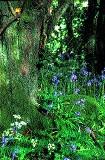First-ever inventory of Northern Ireland’s ancient woodland
Published in 20th-century / Contemporary History, Issue 3 (Autumn 2004), News, Volume 12
Ancient woodland at Drumlamph, Co. Londonderry, in the care of Northern Ireland’s Woodland Trust. (WTPL/Steven Kind)
Northern Ireland’s oldest woods have been a well-kept secret for many years. Remarkably, there has never been a comprehensive record of the country’s ancient woodland, meaning that this rare resource is afforded little or no protection. Now, thanks to funding from the Heritage Lottery Fund and the Environment and Heritage Service, the Woodland Trust is well on the way towards compiling the first-ever inventory of ancient woodland in Northern Ireland.
Ancient woodland (land continuously wooded since at least 1600) is irreplaceable and, having evolved over centuries, is our richest wildlife habitat. But intensive agriculture and modern development continue to take their toll, leaving little room for the country’s woodland and wildlife. Knowledge of the extent and location of our ancient woodland is a vital first step in raising awareness of its plight.
The first year’s initial research, carried out by Queen’s University, Belfast, on behalf of the Trust, has unearthed some surprising and exciting results, with desk-based studies suggesting more than twice as many long-established woods (land wooded since at least 1830) than initially estimated by the Trust. While the preliminary results are encouraging, the majority of these woods are very small and in total cover less than one per cent of the Northern Ireland landscape. Unlike the rest of the United Kingdom, particularly southern England, Northern Ireland has very few ancient trees. The oldest oak in Ireland is thought to be approximately 350 years old, compared to specimens in England dating back to the 1400s. Of the already scarce woodland left in 1600, nine-tenths is thought to have disappeared by 1830.
The Woodland Trust has now commenced the second phase of its project. Current field survey work will identify a range of features, including ancient trees and plant species, which could be significant in determining a wood’s history. The survey work is backed by detailed historical research; the two will combine to verify which woods date back to 1600 and are therefore ‘ancient’.
Historical research is focusing on seventeenth-century sources such as the Bodley maps of 1609, Raven’s maps of the Clandeboye estate from 1625, Petty maps from the 1650s and the Civil Survey of 1654. Initially it was thought that there would be a lack of material owing to the various misfortunes that have befallen Irish records, but fortunately copies of such early records do exist. These surveys and maps were created mainly as a consequence of the Plantation of Ulster and therefore tend to cover the west of Ulster. Other records that are being consulted include estate maps, Ordnance Survey Memoirs from the 1830s and the county registers of trees. These sources can help to suggest which woodlands are the result of planting in the years prior to the 1830s rather than being ‘natural’.
The end result—an ancient woodland inventory for Northern Ireland—will signal a more optimistic future for our country’s priceless woodland heritage.
Enquiries: (028) 91 275787, www.backonthemap.org.uk
















